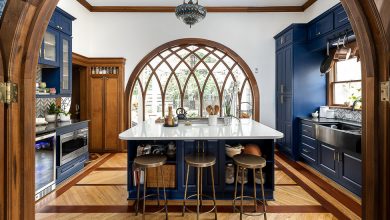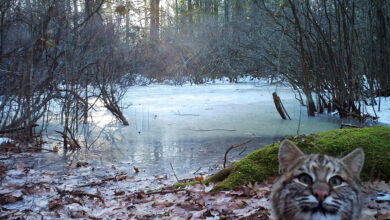Your Garden May Be Pretty, but Is It Ecologically Sound?

Some gardeners react to any mention of ecological landscaping — the merging of environmental science and art — as if it were a compromise or concession meant to limit their creativity. Darrel Morrison, a landscape architect who has been practicing and teaching this philosophy for some five decades, begs to differ.
“There is the implication that you are suggesting a vegan diet,” said Mr. Morrison, the creator of influential designs at Storm King Art Center, in Orange County, N.Y., the Brooklyn Botanic Garden and the Lady Bird Johnson Wildflower Center in Austin, Texas. “A lot of people, when they hear a phrase like ‘ecologically sound landscaping,’ they think they are giving up something. But they are not — it only enhances the experience.”
From his perspective, the real compromise would be focusing purely on the ornamental aspect of our landscape designs, large or small. It’s in the boxwood-and-vinca world that we risk suffering from sensory deprivation, he asserts — not when we use native plants in designs inspired by wild plant communities.
What happens when each plant is chosen and placed purely for show, with no other potential attributes considered? “It looks good,” he said. “Then it’s gone.”
At 84, Mr. Morrison is the self-described elder statesman of his trade. An honorary faculty associate at the University of Wisconsin-Madison, where he did his graduate degree and then taught landscape design from 1969 to 1983, he is also an emeritus professor and a former dean at the University of Georgia, where he worked from 1983 to 2005. Mr. Morrison chronicles that career, and his life, in “Beauty of the Wild: A Life Designing Landscapes Inspired by Nature,” recently published by the Library of American Landscape History.
Merging Ecology With Design
Native plant communities “provide the logical starting point for designing beautiful, functioning regional landscapes,” Mr. Morrison writes, crediting the idea to the groundbreaking 1929 book by Edith A. Roberts and Elsa Rehmann, “American Plants for American Gardens,” which a colleague introduced him to in the 1960s.
One chapter title in his own book states the mantra succinctly: “Merging Ecology With Design.”
Of all the American scenes, the prairie is Mr. Morrison’s “pet landscape.” He grew up on a piece of Iowa prairie turned cropland, on a farm where two small tracts of native plants persisted — his introduction to prairie flora.
The gestalt and palette of the American prairie show up repeatedly in his work, from the design for the University of Wisconsin Arboretum Native Plant Garden, in Madison, to the stretch of cedar planter boxes on his apartment terrace, which he calls his “compressed prairie” — where he can feel at home among the little bluestem grasses and a succession of forbs, “my old friends from the Iowa roadside.”
Whatever habitat inspires a particular design — an Eastern meadow at a classic example of modern architecture known as the Round House, in Wilton, Conn., or an early successional deciduous forest at New York Botanical Garden’s historic Stone Mill — he wants to know it intimately, firsthand, before he starts designing.
It was the Pine Barrens ecosystem in New Jersey that he invoked for part of a project at the Brooklyn Botanic Garden, which debuted in 2013. Mr. Morrison’s inspiration was drawn from field trips spent botanizing and otherwise exploring the Pine Barrens with Ulrich Lorimer, who was then curator of the botanic garden’s Native Flora Garden. Mr. Lorimer said he was struck by Mr. Morrison’s “joy and enthusiasm for projects, plants and places.”
“He was as happy as a 12-year-old, trying to see what Mother Nature does there and then work it into a design,” said Mr. Lorimer, who is now the director of horticulture for the Native Plant Trust in Massachusetts. “Science has kind of divorced itself from spirituality and emotion, but Darrel cultivates that experiential side of what landscapes evoke in us.”
Four Principles to Design By
In his teaching, as in his own practice, Mr. Morrison keeps four goals in mind — the four characteristics of a successful landscape design.
First, it must be ecologically or environmentally sound, meaning that it has a level of natural diversity that will provide resilience against climate change.
“The species in the landscape must be adapted to the site and region, and hence not require a lot of support like watering or applying poisons to the earth,” he said. “It also means we don’t introduce nonnative invasives that will diminish diversity.”
A landscape must also be experientially rich, beyond the visual dimension. That means considering “the nonvisual aspects: the feel of the wind, the aroma of prairie dropseed grass that permeates the air,” he said. “And the other forms of life, too: the bees and butterflies that move through it.”
A design must, likewise, be of the place — averting the fate conjured in a favorite quote. “When you have standardized landscapes with the same plants, all irrigated and on artificial support, ‘there is no there there,’” he said, borrowing from Gertrude Stein. “A native landscape gives you a clue of where you are. You should know if you are in Des Moines or Connecticut.”
Last, a landscape must be dynamic, changing over time. “We spend all kinds of effort to keep our landscapes looking the same, mowed and clipped and unchanged,” Mr. Morrison said. “You are missing out by doing that, missing out on the change from one growing season to another, and over time.”
Our gardens are evolving compositions, not something we can restrain. “Painting is two-dimensional; architecture and sculpture, three-dimensional,” he said. “But landscapes are four-dimensional, with time being the fourth dimension.”
He added: “I set things in motion, and let them go.”
There are, however, a few exceptions. Some focused trimming may be necessary to keep a key vista open, and some editing to keep invasive plants in check, “or you lose the spatial composition,” he said. “It isn’t completely carefree.”
Landscape Luminosity
Others — including more than 1,000 university students who studied landscape design with him, and many thousands who did so in less formal settings like symposiums — may quote or credit Mr. Morrison as an inspiration. But he continues to nod to those he learned from, whose foundations he has built upon.
They include the conservationist Aldo Leopold — like Mr. Morrison, a native son of Iowa, and of the University of Wisconsin. In his 1949 book, “A Sand County Almanac,” Mr. Leopold wrote that “our ability to perceive quality in nature begins, as in art, with the pretty.”
“The pretty element in a composition may be the way in,” Mr. Morrison said. “But then you start to see the patterns. And then you begin to understand the processes that led to them that you can integrate into your designs.”
Another indelible impression was delivered in a 1967 essay by the landscape architect Arthur Edwin Bye, titled “What You See: Landscape Luminosity”: the idea of placing plants with translucent foliage in areas where they will be backlit part of the day. Mr. Morrison urges us to do this with ferns, for example.
As Mr. Lorimer noted, “Darrel is not afraid to talk about the ethereal qualities of grass seed heads, or their luminosity.”
The design process he taught students has an ethereal, luminous quality to it, as well. The creative spark for a landscape design could come from a painting — the energy of a vintage 1914 Kandinsky or “the swirling strokes of Van Gogh that conjure movement” — or even from a piece of music.
“Music is so good at getting you out of a rut,” Mr. Morrison said. “What I like to do, and have students do, is have overlays over their base map of a site and let flowing music carry them, especially in the very early stages of a design — a freeing up of one’s mind.”
A few recommendations: the pianist George Duke’s “Muir Woods Suite”; Puccini’s aria “Nessun Dorma,” from the opera “Turandot”; and Bedrich Smetana’s “The Moldau,” the story of a flowing river.
But it is the Danish-born landscape architect Jens Jensen whom Mr. Morrison calls “the person who most influenced me as a teacher and designer,” although the two never met.
When a colleague Mr. Morrison taught with at Madison once asked why he insisted that gently curving paths were more desirable in woodland or prairie designs than straight ones, Mr. Morrison’s answer was almost Zen — and very Jensen: “Because the view is always changing on a curving path.”
‘You Slept on the Land’
For Mr. Morrison, ever the willing pupil, every place has something we can learn from, especially the natural areas.
In 1992, when he was engaged by the Lady Bird Johnson Wildflower Center, nine miles from downtown Austin, he borrowed a sleeping bag and tent, and spent the first night camped out on the 42-acre site.
“It’s a good thing to do: to see the sun go down, smell the smells of the junipers, hear the morning birdsong,” he said. “I think you do know the place better for it.”
Apparently, that got the former first lady’s attention. Years later, Mrs. Johnson was receiving guests at a reception. She had suffered a stroke and her eyesight was diminished, so when Mr. Morrison reached the head of the line, he reintroduced himself: “You may remember me, Mrs. Johnson. I’m Darrel Morrison.”
“Of course, I remember you, Darrel,” she replied. “I tell all my friends how you slept on the land.”
Margaret Roach is the creator of the website and podcast A Way to Garden, and a book of the same name.
For weekly email updates on residential real estate news, sign up here. Follow us on Twitter: @nytrealestate.






